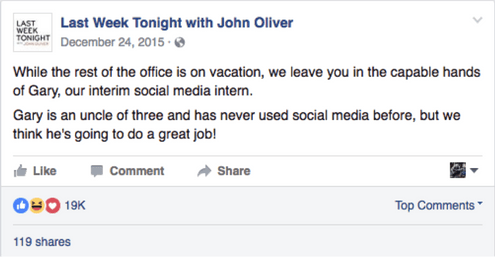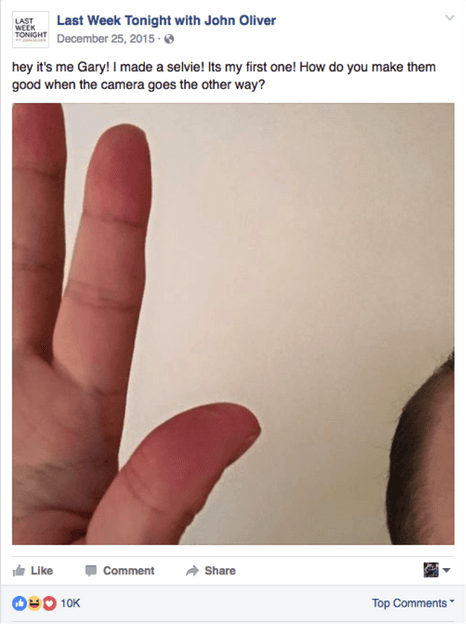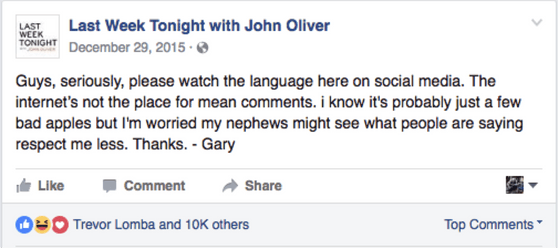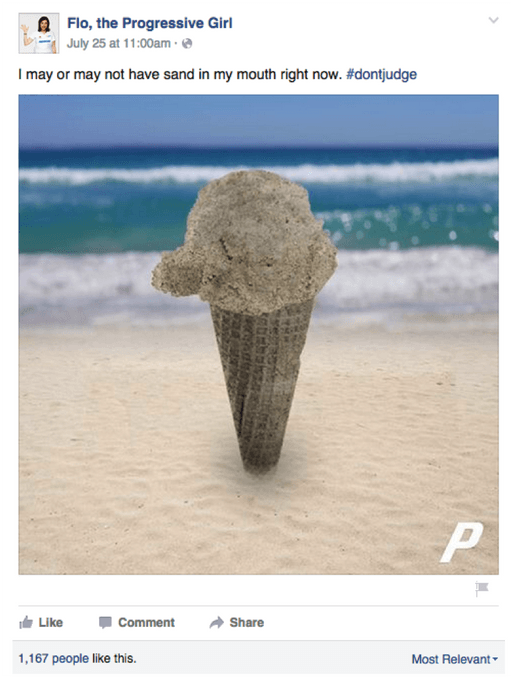Why Last Week Tonight’s Social Media Team is Digital Marketing Gold
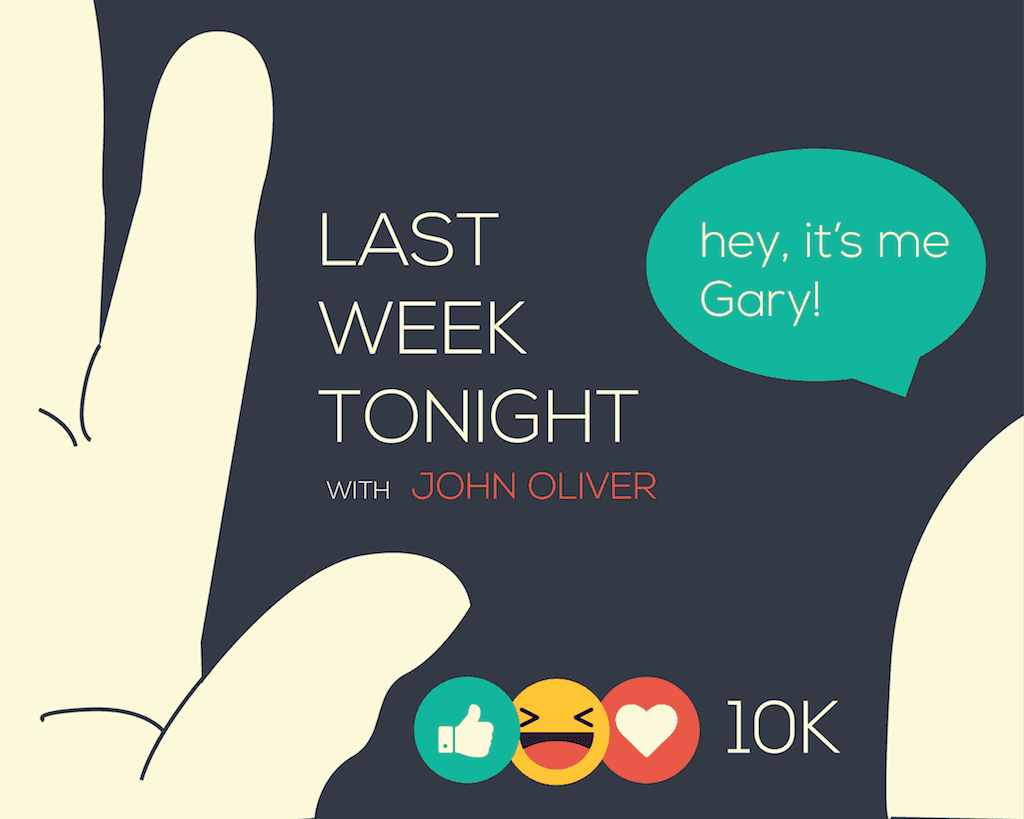
Last Week Tonight with John Oliver is a true TV gem.
As a news junkie and comedy lover, I became an avid fan of the weekly late-night HBO show as soon as the first episode popped up in April of 2014. From FIFA’s corruption allegations to predatory televangelist churches, John Oliver somehow manages to turn any topic into comedic gold.
But there’s another thing Last Week Tonight is insanely good at other than injecting John Oliver’s sarcastic British humor into investigative news — maintaining its social media presence.
Meet Gary, Last Week Tonight’s Interim Social Media Intern
When Last Week Tonight announced a two-month hiatus after the end of season two last year, I expected the show to disappear from the web save for a few reminders about the upcoming season. Besides, it was the end of December and the next two months were going to be busy with Christmas, New Year’s and other end-of-the-year festivities.
That’s when the show introduced us to Gary, the show’s interim social media intern.
Gary was an uncle of three, and he’d never used social media before. But he was going to be in charge of the Facebook and Twitter accounts for one of HBO’s most successful shows during a critical time when interests could dwindle.
I remember thinking, ‘This is weird.’ It was a surprising approach to personifying your brand — what kind of marketing team could even think of branding your web presence as a middle-aged man struggling with modern technology?
Well, it turned out Last Week Tonight’s social media strategy wasn’t so crazy after all. The first post introducing Gary as the new social media overlord received 19K likes — more than what some video postings of actual show segments were getting.
Gary’s first post — a terrible attempt at a selfie with the caption “hey it’s me Gary! I made a selvie! Its my first one!” — continued to receive a huge number of positive engagement. Something about Gary clicked with the audience, and the numbers were showing it.
Gary’s social media escapades continued for over a month, and his adorably clueless status updates including absurd statistics and odd comments collected thousands of engagements — many posts regularly reaching and surpassing 10K likes.
When Gary wasn’t “Twitting,” he was naïvely commenting on the mean trolls. Quote of the day: “The internet’s not the place for mean comments.” – Gary, 2015
It was brilliant. Gary posted almost daily, and I soon realized that even though the show was off-air for another whole month, I kept going back to the Facebook page every day to see what dumb thing Gary said.
Unsurprisingly, Last Week Tonight’s third season kicked off strong with 1.02 U.S. million viewers — much higher than the previous season’s disappointing premiere with 0.72 million viewers.
Yes, the show had already proven to be a critical and commercial success, and there clearly were other marketing campaigns aggressively promoting the show. But without Gary’s hilarious status updates to maintain intrigue and buzz during the show’s long hiatus, would nearly as many viewers have tuned in for the season premiere?
Why Brand Personification Works
It’s no secret that consumers respond better to personified brands than cold corporate entities. Just take a look at Tony the Tiger, who’s been hustling Frosted Flakes for more than half a decade. Or look at Flo, the Progressive Girl, who’s racked up almost 5 million total page likes and averages almost 3,000 likes per post.
The numbers show everything: a study even found that personified brand mascots generate more social media buzz than celebrities. Whether it’s an overly enthusiastic saleswoman or a talking tiger, brand mascots often find success because it humanizes the product and encourages casual conversation and engagement.
And even though Last Week Tonight doesn’t have an official mascot per se, its brilliant attempt at social media brand personification was a success. Gary, the technologically impaired interim social media intern, had made it.
Of course, “Gary” is probably just a joke that Last Week Tonight’s social media team came up with in order to keep interests piqued during the show’s downtime. “Gary” probably doesn’t even exist. But it’s a joke that worked wonders for the show’s digital marketing purposes.
What sets Last Week Tonight’s social media strategy apart is that Gary is an image that viewers could relate to on a personal level, even more so than a talking animal or a happy-go-lucky cashier girl.
Gary is a typical middle-aged man. Gary has three nephews. Gary doesn’t like Internet trolls. Gary is clueless about what he’s supposed to do. Gary’s our uncles, dads and ourselves. Gary is anything but a cold, profit-hungry, all-knowing corporate entity — Gary is one of us.
Maybe that’s why even though I knew he’s just a human mask hiding a huge studio machine, I loved every single moment of Gary’s Facebook and Twitter presence.
Let’s hope for Gary’s dramatic return to social media as Last Week Tonight wraps up another successful season.
—
Are you a social media newbie like Gary? Don’t worry, we’ve all been there. Stop being clueless and check out our guide to Instagram, Pinterest & Twitter marketing!
Do you know any other great examples of brand personification on social media? Tweet us @Perfect_Search.

